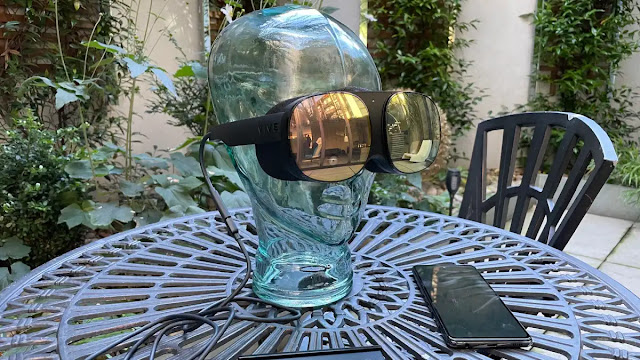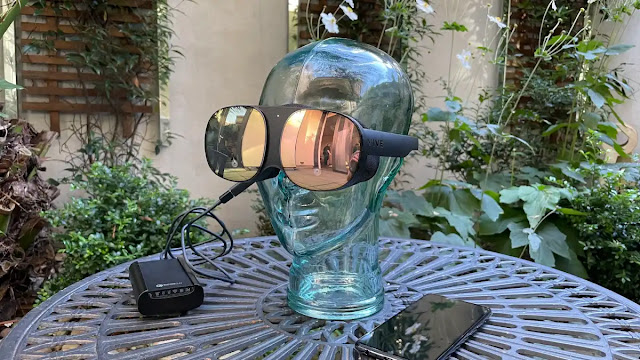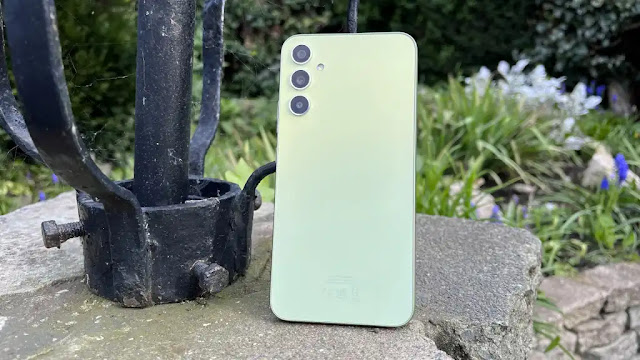The Vive Flow had many lofty goals, but actually reached few of them.
Pros
- Sunglasses-like form factor
- Lightweight, portable design
- Can view your phone apps on a 100in display
Cons
- Needs an external battery source
- Only compatible with select Android smartphones
- VR experiences are closer to that of first-gen VR headsets
- Expensive
Our Verdict
The Vive brand has had an interesting few years; despite huge interest from consumers in the early days of VR, the brand has shifted more towards the B2B market over the past few years with the likes of the Vive Pro and Vive Flow 3.
That’s set to change with the Vive Flow, a VR headset that isn’t really a VR headset. Instead, HTC describes its latest headset as a pair of “immersive glasses”, sporting a sunglasses-like design and an impressive lightweight build. Intrigued? Confused? All of the above? Great, then let me explain.
Design & build
- Sunglasses-style design is unique
- Not front-heavy like standard VR headsets
- Innovative lens focusing system ideal for glasses-wearers
- Needs an external power source to function
The Vive Flow isn’t your bog-standard VR headset, and that’s most evident from its design. It’s closer in look to a pair of smart glasses than a full VR headset, sporting large brightly coloured reflective lenses that look almost fashionable – if not a bit superhero-esque.
It’s not just for the style either; there are plenty of benefits that come from a decidedly more streamlined design.
That’s complemented by a soft-touch face gasket that snaps into place via magnets, or if you want a more open experience, there’s also a nose insert in the box.
That all equates to a headset that’s much less front-heavy than alternatives, and that expands potential use – in theory, anyway.
The downside, for me at least, is the rigid arms that hold the headset into place. They’re styled like sunglasses arms but they’re longer, thicker and tighter at the rear, with a noticeable build-up of pressure on the back of the head after around 30 minutes of use.
Accentuating the uncomfortable arms is a USB-C cable that runs from the right arm. What’s the cable for, you ask? It’s needed to power the headset. Yep, the headset doesn’t come with a built-in battery – or one that’ll last more than a few seconds without power, anyway. How else could HTC make a headset that weighs just 189g?
The display housed within is fairly impressive, boasting a 3.2K resolution roughly split at 1.6K per eye, with a combination of a 100-degree field of view (FOV) and a 75Hz refresh rate.
It comes in at slightly lower than Meta’s standalone headset, but with a narrower field of view, there isn’t a discernible difference in overall quality. It’s vivid, bright and plenty detailed for the VR experiences on offer.
Where the Flow beats the Quest and practically every other headset is in the lens department, with an intuitive focus system that’s ideal for glasses-wearers.
Rather than forcing glasses-wearers to wear the Vive Focus over their existing glasses, the Flow offers a wide manual focus range (from 0 – +6) that negates the need for glasses entirely. As someone that wears glasses on a daily basis, it’s a huge deal, and something I’d love to see on other VR headsets in future.
Setup & Compatibility
- Only compatible with a small selection of Android smartphones
- Straightforward setup process
- iPhone support coming sometime in the future, but no word when
If there’s one sticking point for the Vive Flow, it’ll no doubt be its compatibility.
HTC claims that the Vive Flow doesn’t need a top-end smartphone to power the headset, providing a £409/$425 Samsung Galaxy A52s along with the headset for review, and that claim is largely true – I did use the A52s for most VR experiences, and it ran just fine.
The problem is that the Vive Flow isn’t compatible with all Android smartphones, and there’s no hard-and-fast rule about which handsets do and which don’t. HTC provides a list of confirmed models on its site, but compared to the wider phone industry, it’s a small fraction.
It’s not even guaranteed on top-end smartphones, as I tried using the Vive Flow with the likes of the Oppo Find X5 Pro and Asus ROG Phone 5 to find out that they don’t support all features and functionality of the headset.
The suggestion the Vive Flow provides when it tells you this during setup? To use another smartphone. Considering most users won’t have multiple phones laying around to use, it’s crucial that you confirm whether your phone is compatible before you buy.
Oh, and if you’ve got an iPhone, you’re completely out of luck – for now, anyway. HTC has teased that iPhone support is on the way, but there’s no word when that might be.
Once you’ve confirmed you’ve got a compatible smartphone, the setup is a breeze. Simply download the Vive app from Google Play and follow the on-screen instructions.
It’ll take you through the initial login process, help you adjust focus, test whether your phone is fully compatible with its phone mirroring mode, and it’ll show you how to use the controls too.
The whole process shouldn’t take longer than five minutes or so, and then you’re free to explore the Vive Flow’s virtual world.
The Vive Flow Experience
- Uses smartphone as a controller with on-screen controls
- VR experience is closer to first-gen VR headsets than 2022 competition
- Phone mirroring is great for watching movies, but not playing games
At the heart of the Vive Flow is Qualcomm’s Snapdragon XR1 chipset, which came out way back in 2018 and is pretty underpowered compared to the upgraded XR2 chipset found in the likes of the standalone Meta Quest 2 and HTC’s own Vive Focus 3.
For that reason, the VR experience isn’t quite as high-end as Meta’s option, running a custom version of Android with support for two main functions; immersive VR experiences and the ability to mirror your phone’s display virtually.
It’s the latter that’s most interesting for users, but there’s a lot to unpack first.
Tracking
Firstly, two embedded cameras mounted in the lenses of the sunglasses-style VR headset enable positional tracking in a space of up to 4m x 4m.
It’s a similar system to the Quest 2 and HP Reverb G2, but with far fewer cameras than alternatives, the Vive Flow’s positional tracking can sometimes feel floaty and more akin to a basic 3DoF smartphone VR viewer than a ‘proper’ VR headset.
It’s arguable that the connected nature of the headset means it’s better suited to sit-down experiences, and this doesn’t impact the overall experience too much, but the hit-and-miss tracking means you won’t feel comfortable getting up and moving around in VR even if you wanted to.
Controller
You might’ve noticed that I’ve yet to mention the controller used with the Vive Flow, and that’s because there isn’t one. Instead, you interact with the virtual world using your connected smartphone as a controller.
The idea seems solid, especially when you consider that most use cases for the Vive Flow are when you’re travelling, as it means you don’t need to carry around an additional controller as well as the headset, your phone and potentially a battery pack too.
However, the implementation is far from ideal.
Once set up on your smartphone, the virtual controller UI should appear on-screen when you put the Vive Flow on. Activate it by holding two fingers on-screen and disable it by swiping down from the top of your display.
The bigger issue is that, without a dedicated controller, the system is limited to using the gyroscope of your phone to track its position, and that means it doesn’t provide true 1:1 tracking.
Your phone might be in one place in VR and another in the real world, making for a disjointed, floaty experience, further frustrated by awkward UI placements that sometimes make it hard to navigate across virtual menus without having to awkwardly angle your controller.
Essentially, it’s more in line with the 3DoF controller of the Samsung Gear VR and Google Daydream, headsets that were launched way back in 2016, and can really detract from the VR experience – especially in dedicated VR apps.
HTC claims that hand tracking is coming, but as with iPhone support, there’s no word as to when to expect it.
VR Apps
You can access HTC’s Viveport VR storefront from within the headset, allowing you to install a range of VR apps. But, if you’re picturing titles like Beat Saber and Resident Evil 4, you’ll likely be disappointed.
Instead, the offering is more akin to that of early VR viewers like Google Cardboard and Gear VR, with basic look-and-shoot games, on-wheels VR experiences and other simplistic VR apps.
There are a few exceptions to the rule, with (the aptly named) Flow offering a unique way to meditate while keeping your eyes open, and the art style of Curious Alice provides a genuinely unique experience (even if gameplay is rather basic) but it’s certainly limited compared to Meta’s offering.
The other problem is that the ageing Snapdragon XR1 chipset in the headset can sometimes struggle to power the experiences available on Viveport, with some struggling to maintain a decent 75fps (the widely regarded minimum for VR without inducing motion sickness and discomfort).
The caveat to all this is that it has the potential to improve over time, but it needs more content specific to the Vive Flow and its unique capabilities. More meditation apps like Flow, and fewer first-gen VR games, please!
Phone Mirroring
While the library of standalone VR apps leaves much to be desired, the main draw of the Vive Flow for many will be the ability to mirror your phone’s display within the headset on a large, curved 100in display.
HTC opted to use Miracast mirroring technology in place of using the USB-C cable to mirror any connected display, primarily because Miracast lets you interact with your smartphone display while in VR. It’s also incidentally one of the big barriers with smartphone compatibility mentioned earlier, but hey, if it works it works!
Using the smartphone controller, you can scroll through Instagram, TikTok and any other app you have installed on your smartphone. It’s fully compatible with apps that use DRM like Disney+ and Netflix, allowing you to enjoy a cinema-esque big screen experience wherever you are.
The backless design of the glasses also means it’s easier to lay back and enjoy an episode of Stranger Things on Netflix than most other headsets.
But, in a running theme for the Vive Flow, there’s a caveat to the phone mirroring capabilities.
While Miracast undoubtedly has VR-focused benefits over using simple USB-C display mirroring that isn’t interactive, it also means there’s a slight display lag. It’s less than a second, but that delay means you can’t reliably play games – local or cloud-based – on the Vive Flow.
That’s a real shame too, considering just how large that virtual display is.
It also means that you can’t mirror, say, a USB-C-connected laptop, expanding the Vive Flow’s capabilities from entertainment to work.
It’s worth pointing out that the Nreal Air AR glasses do use USB-C connectivity for display mirroring, and while you can’t interact with it in the same way as the Vive Flow, the low latency, great display quality and the ability to play cloud games like Red Dead Redemption 2 on a virtual display is a real treat.
If that’s more your thing, perhaps Nreal’s option is better suited to you – and it’s a little cheaper too.
Price
The Vive Flow comes in at a not-insignificant £499/$499, making it a hard sell when compared to the bulkier, but also way more capable £299/$299 Meta Quest 2. Even the Nreal Air glasses, with lagless mirroring and AR capabilities, costs less in the UK at £399.
If you are tempted, you can purchase the Vive Flow from the Vive website as well as retailers like Amazon (albeit at a premium) with a free protective case and a free Viveport Infinity trial to sweeten the deal.
To see how the Vive Flow compares to the competition, take a look at our selection of the best VR headsets.
Verdict
The idea behind the Vive Flow is solid; offer an entertainment-focused virtual experience that doesn’t need the graphical grunt of the Meta Quest 2, saving on overall weight and bulk for a more comfortable encounter.
The ability to mirror your phone’s display is a great touch, allowing you to stream from the likes of Netflix and Disney+ onto a curved 100in display in a virtual space without a cable – though you’ll still need to plug the headset’s USB-C cable into something to give it power, lacking an internal battery.
The problem is that the core VR experience is more akin to that of a first-gen VR headset than something available in 2022, while the phone controller is a good idea with a somewhat flawed execution.
Couple that with spotty Android phone support, a high price tag and mirroring lag that makes playing games impossible and it’s a pretty hard sell, with Nreal Air offering a better mirroring experience and the Quest 2 offering a better VR experience, both at a cheaper price point than Vive’s option.
























0 comments:
Post a Comment